Who Designs and Directs in LORT Theatres by Gender
Phase Two
In 2015, I started working on a project about designers in League of Resident Theatres (LORT) because I wanted to know who gets hired to design in US regional theatres. Phase two of the LORT designers study continues to collect data on gender of designers, and begins to look at directors and artistic directors, partially in relation to designers. In continuing the work of the study, I hope to establish a baseline and foster a conversation for where we hope to be in the future. Collection and confirmation methods remained the same: In cases where theatres run their seasons yearly, the 2013 season was combined with the 2012–13 season for statistical purposes, and so forth. Only lead designers, no assistants or associates, were counted. In cases where multiple designers worked as co-designers, they each got partial credit. For example, Joe and Jane were the co-scenic designers of a production, so they each received 0.5 in the designer counting.
Many people have asked me to also examine religious affiliations, sexual orientations, and annual incomes, among other things, but these are all data that I feel has to be self-identified in order to have any validity. Though I completely believe that gender and race have intersecting effects, I still haven’t figured out a way to study race/ethnicity, so I did not include it. Some have suggested that I guess, by names or photos if I can find them, but as a woman of color with the last name “McGovern” and a habit of avoiding photos like the plague, I know that that simply won’t work.
I also wish that this study didn’t support the stereotypical gender binary, and that there was a way for me to identify trans*/gender fluid/gender nonconforming/agender designers in another category, but unfortunately that was not possible at this time.
This year’s phase is different in a few ways from last year’s. I took certain suggestions from the comment section of the previous article and private emails. All data, not just confirmed, is included in the charts and graphs.
I also looked at directors and artistic directors, partially to see if there was any correlation to designers. After phase one, several people wrote to say that once there was more gender parity amongst directors and artistic directors, this would achieve greater gender parity in the design fields. I decided to look at the hard data to see if that was currently the trend. I can’t say strongly enough that correlation does not imply causation.
Some theatres who responded last year didn’t respond this year, and vice versa, so confirmation percentages are different between designers and directors/artistic directors. In eliminating the earlier years of the study, I had enough data to look at projection/video designers, but it’s still a much smaller number than the other design disciplines.
I also studied the differences between the four regions of the country (as defined by the Census Bureau).
Click here to view a larger image—
I researched how the different categories of theatres correlated with percentages of designers and directors.
Click here to view a larger image—
In addition, I figured out how many productions the most prolific designers and directors work on, in comparison to the rest of the field.
Click here to view a larger image—
Of the then-seventy two theatres, fifty-seven responded with confirmation of 1253 of the 1587 productions. All the graphs are based on both confirmed and unconfirmed information. Designer data is 85.8 percent confirmed, while director and artistic director data is 79 percent confirmed. In the case of one theatre, the “head” of the theatre is an executive director rather than an artistic director, so that’s the information I used for the statistics.
If you work at one of these theatres and would like your specific statistics, or would like to confirm information for future phases of this study, please write me at [email protected] from your institutional email, and I’ll happily send them to you. Please allow forty-eight hours for a response.



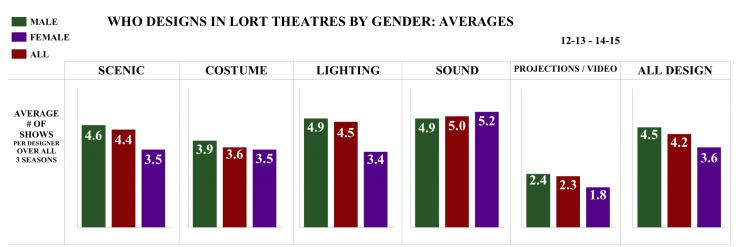
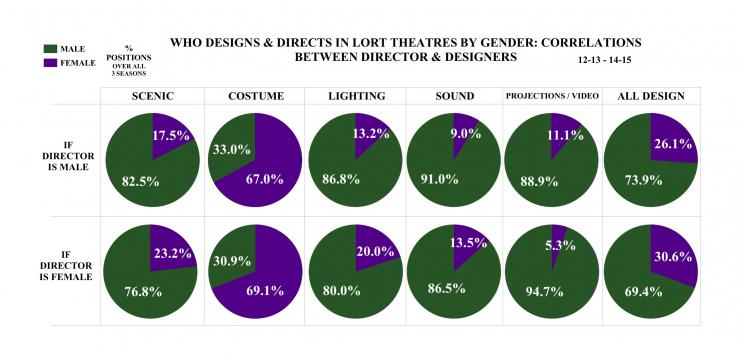

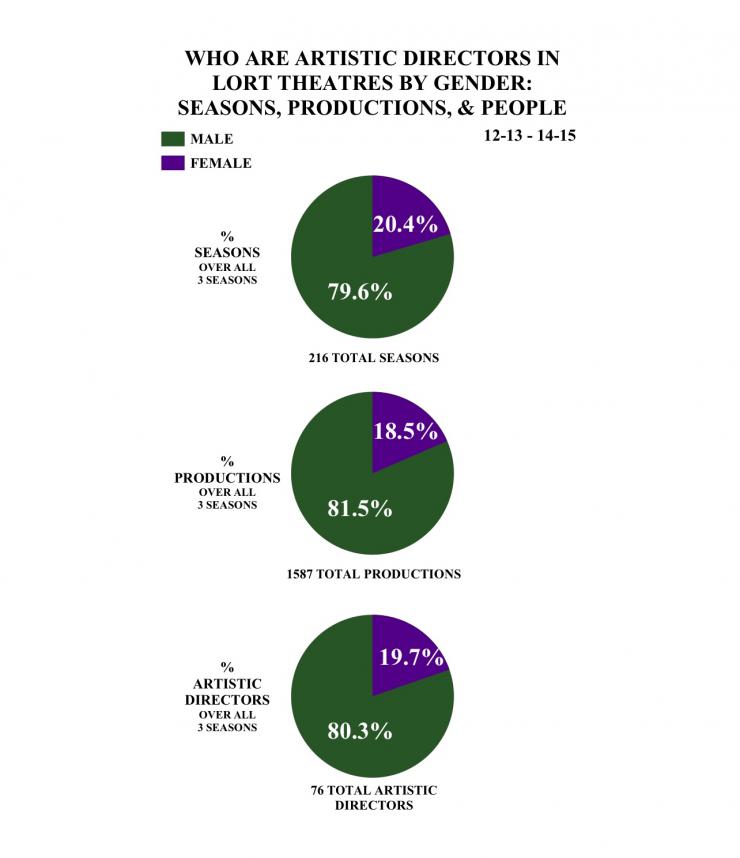
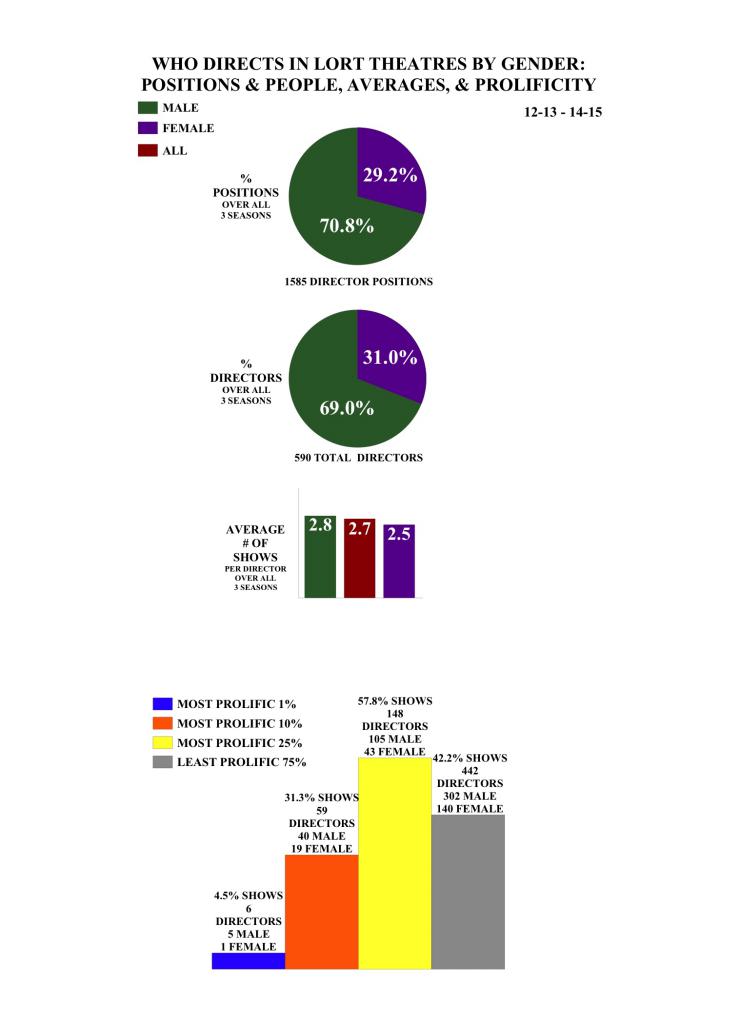
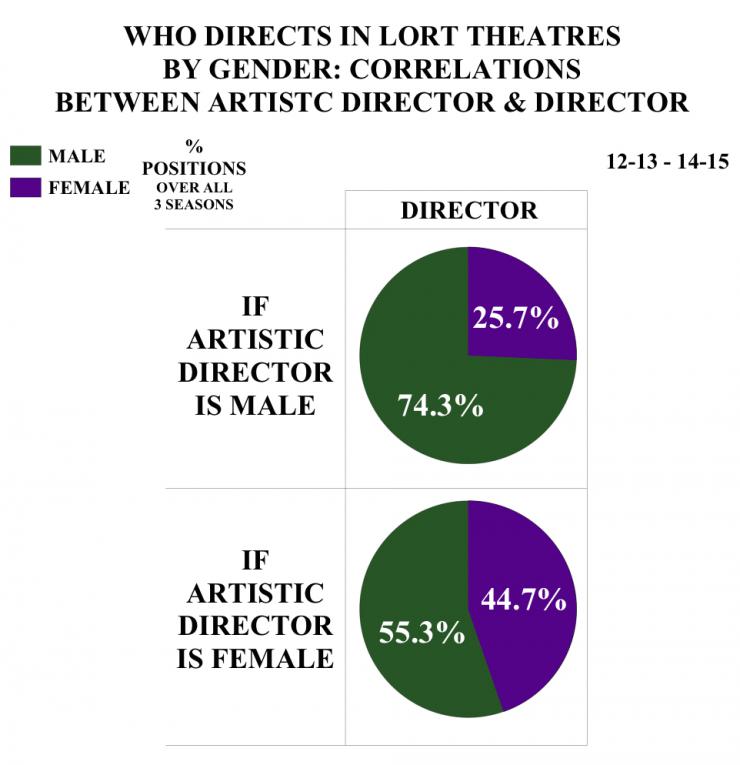
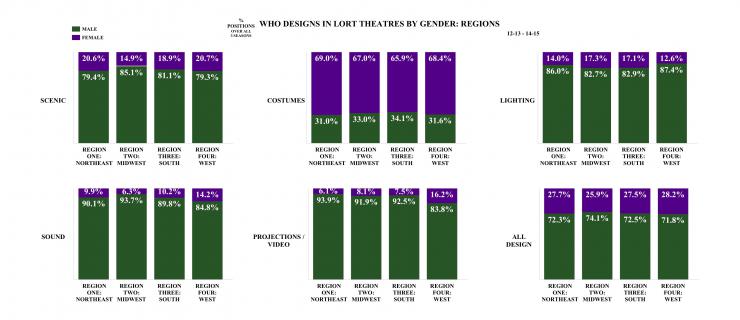
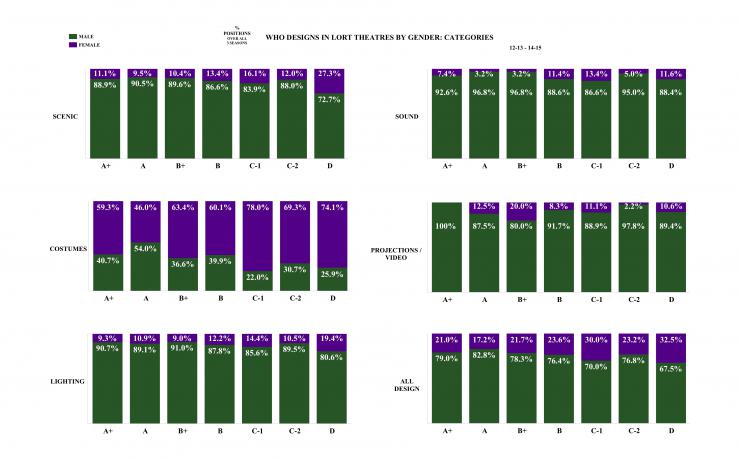
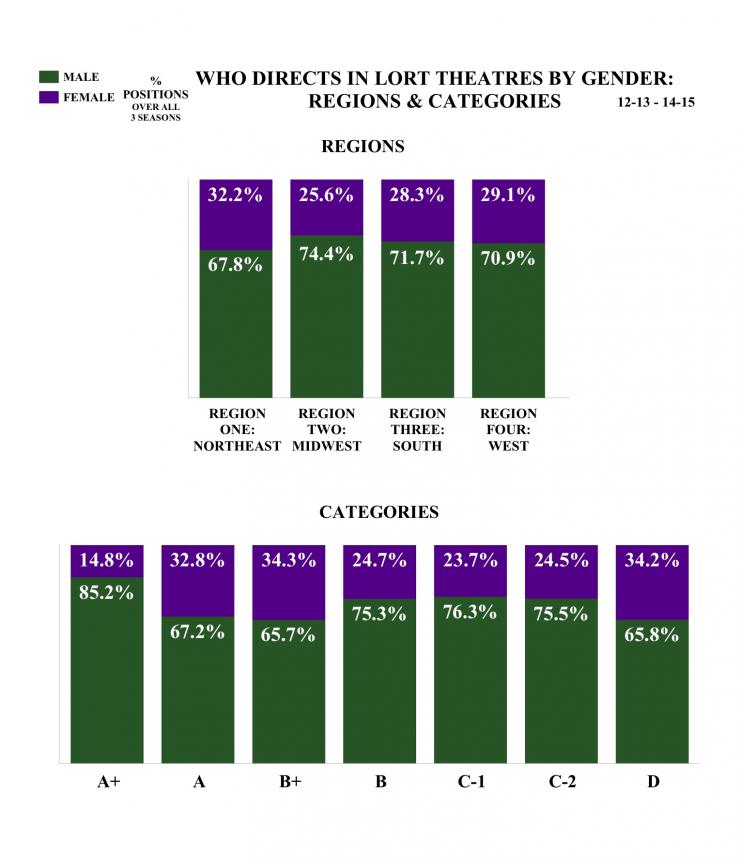

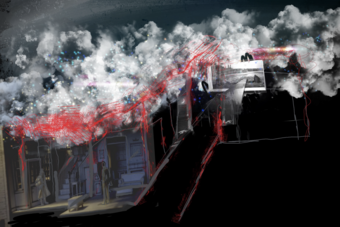


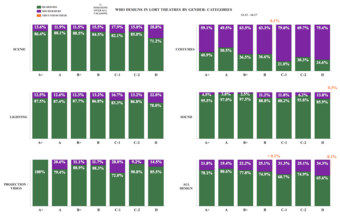


Comments
The article is just the start of the conversation—we want to know what you think about this subject, too! HowlRound is a space for knowledge-sharing, and we welcome spirited, thoughtful, and on-topic dialogue. Find our full comments policy here
I'm rather surprised by really only one thing in this study, Porsche. In LORT A theatres, women are in the minority for costume design?!? Most theatres I think "make up" for their lack of women on the creative team with costume designers. Costume designers have traditionally been a women's domain (I worked in HR for a brief period and learned the incredibly offensive term, "pink collar job") and I think it's the one design field where almost every MFA program in the country has had majority women in the last 25 years at least (again, anecdotal evidence only). So why, at the majority of the top regional theatres in this country, is there this disparity?
I'm just a little floored by that.
Thank you so much for this work, Porsche.
Thanks for reading and your kind words, Megan. And for anyone looking for diverse designers and technicians, Megan started this; https://docs.google.com/spr...
It's so important to keep showing the gender disparities in our business. We need more women in all of these places. However, we also need more women on onstage. A big push needs to be against the playwrights who are not writing enough roles for women. Also, as an artistic director of a graduate training program, I'd say that much of the battle needs to happen at our level. It's important to begin the battle when people are being shaped. I try to make certain that women are an important part of the pool of guest directors I bring in.
Finally, I think it's important to point out that there are categories that are vital in creating a production that are a part of the design team that are left out where information is also needed: choreographers (dance & fight), music directors, and (where I live) the voice/accent coaches. I'm sure I'm forgetting others, but we'd like to see the numbers in these areas as well.
Do the study on non-LORT companies and see how many women with equivalent training and experience are directing and running non-profits that are locked out at LORT's door.
That would be great. It is completely beyond my current bandwidth to study that many theatres by myself.
If you see a cloud over Phoenix, it's the steam coming out of my ears -- NOTHING HAS CHANGED in the 11 years since I did some similar descriptive statistical research about lighting designers. If anything, things are more gender-skewed now than a decade or more ago.
THANK YOU for doing this work and for showing that affirmative hiring policies will be necessary to mitigate the endemic inequities your statistics illuminate.
PS> here's the rest of my response: https://creativeinfrastruct...
Thank you, Linda! Your response is fantastic.
This is great. Thanks so much for all this data. Lots to think about!
Thank you and yes, the sheer volume of data was staggering at times.
This is sobering and infuriating and not surprising, at all. For those people who think it is, where have you been living? Thank you, Porsche, for doing this work. Thank you for shining a light on the gender disparity.
Thank you for your kind words, Margaret. I believe that having a baseline will help everyone in the theatre.
Does it even matter? I mean if gender is now considered fluid and there is no real gender anyways, none of this even matters.
You're right...totally right....and we shouldn't even consider race either since we are all ORIGINALLY from Africa. Right? Aren't we all people of "color"?
Billy, you are the kind of leader we need in Theatre. Someone who looks in the face of inequality and says "none of this even matters".
I bet a season at your theater would include "Lend Me a Tenor", an Ibsen play, and "The Piano Lesson" (cause you gotta do SOMETHING for "Black" History Month) all designed and directed by "males".
I mean......why give any credence to this well thought out and researched article?
I guess the sarcasm of my post completely missed you.
Second, I never pander. I do not select shows based on anything other than artistic value and marketability.
Third, I don't give a flying f*ck one's skin color or national origin. Can you do the job, yes or no?
Someone in another post asked an important question that was lost on most and it is significant. How many of the people applying for these jobs were men and women and what was the % breakdown? Was the % breakdown equal to or at least close to the % of men/women hired for the positions open? If so there is nothing to see here. All it shows is that more males are interested in theatre than females.
Now if 75% of the applicants were women and then 75% of the hires were men, the theatre community might have some explaining to do, but I doubt that was the case here.
Having been part of the theatre family since I was a teenager and now moving into my 50's, I can safely say that I have always seen more males involved in theatre, except for of course costume and makeup, those are dominated by women.
But again, I do not care who the hell is pulling the rope to raise the set piece, as long as they are able to physically do it, on cue, and do it consistently. The same with any designer I have ever worked with. I cannot even fathom having the mentality of thinking "oh god I need more black people on my set crew". That is just dumb.
In my experience, applications are generally not taken for design jobs at this level. The people in this study are designers, not technical crew who are "pulling the rope to raise the set piece." Designers are a part of the creative team, who help to shape the art and world of the production.
I do know what a designer is. I was speaking in generalities as to any role in the theatre or any other field I work in.
What is the point of the study then? With no background to any of the data other than knowing it was collected, what does it show? Is it to prove that women are overlooked in design positions in the theatre? Are theatre people really sexist and not as liberal and loving as we all thought they were?
How about the same study with the added question of, "have you ever worked with the designer in their current role elsewhere?" Maybe nepotism is more the issue here than gender??
Correcting unconscious bias requires conscious action. The first step is documenting the data. You may not care the identity of the people who create the theater as long as they can get the job done. But very likely, the steps to this quite unequal outcome happened before prospective hires' resumes land on your desk. Maybe the breakdown of the people you look at for design hires matches these numbers. Why? As designers, we don't blind apply for jobs. We are brought into jobs or recommended for jobs or at the very least asked to interview by directors, producers, artistic directors or production managers.
Also, if I can be an idealist for a moment, the backgrounds and histories of the people who collectively tell stories on your stage should matter. If the experiences pulled from to tell stories only encompass a small swath of the culture, many perspectives are being left out and that is a shame. Especially if, most likely, your audience makeup has mostly a female experience.
Thank you.
The point of the study is to provide a baseline to see where we are, and then spark a conversation about where we hope to be. For some theatres and some people, that hoped for future is exactly where we are now. That is not true for others.
In my lifetime in the theatre it is my experience that most theatre folk are the most accepting and open people around. In all my life I have never seen a designer passed up due to gender, ever.
I am not doubting the facts that there are fewer female designers than men, that fact is easy to obtain. But once obtained, what is the objective? From the posts of some of the people on this thread it seems they are suggesting that there is an underlying bias against women in key designer roles and that bias is either right out there or an unconscious bias.
I subscribe to the theory that there are just differences between men and women and what they find enjoyable as careers. While we currently have all this talk about gender fluidity and how men and women are just a construct of society and that we are all just the same, it just is not true.
Why are women not lighting designers? maybe it is the same reason most women couldn't care less how a fuel injector works on a car, who knows. But the point is to just center the reason on general bias is not helpful.
People don't just end up being designers later in life, they begin early in places like high school and earlier when they are introduced to theatre. At that point they begin to lay out their own path for what they desire to be and do in the industry. Why are there more men hired as lighting designers? Because there are more men who desire to be lighting designers than women.
It is not true that more men want to be lighting designers than women. Please look at MFA programs to see that is not true. It is true that people tend to recommend and bring on men into their teams more than woman especially as the stakes get higher in terms of money and reputation. The data shows this. And there are a lot of women very frustrated that they have a harder time finding work. There are real world consequences of this inequality in our abilities to support ourselves and our families. And this inequality is not a result of a lack of talent or expertise. It is a result of a lack of opportunity. The theater is full of liberal people, open minded people. But it is also super saturated with people who want to protect their jobs. This profession is hard enough as it is and there is a good reason for people not to accuse their friends and coworkers of exhibiting or being beneficiaries of male privilege. You don't have to be untalented or a bad person to still benefit from privilege.
Look, i am not saying that women are not interested in lighting design, I am basing my opinions on 30 years in theatre and entertainment. maybe there are equal numbers of women learning lighting design in today's MFA programs across the country and that is great.
Now the point you bring up is probably more accurately the correct answer to this study, and that is self preservation and nepotism. Everyone wants to protect their own job, this is human nature. You also want to work with the people you have worked with before, it makes for a smoother working environment. IMO gender has little or nothing to really do with it. Ask any job recruiter and they will tell you that a recommendation from a person already working within the company is like GOLD to them. yes it is a form of nepotism but it is also good for an organization to bring in someone new that is already a known entity by a trusted employee. This is true for all industries, not just theatre.
Forgive me for jumping up on the soapbox on this but I truly am so sick and tired of everything being made into a bias/sexist/racist/bigoted issue. The numbers do not prove causation just just prove the numbers.
Hey Billy,
I hear your frustration, I really do. Everyone in the theatre relies upon networking/personal recommendations to find good, reliable people for positions. That's not nepotism, it's just how our biz works, right? "Hey, I've worked with Jim, but nobody I knows has worked with Nancy, so I'm going to hire Jim!" I get that.
OK, so why hasn't Nancy worked with anyone? Is it because she's a bad designer? Maybe.
Or because Jim had an easier time getting hired because he was a guy? All it takes is one or two jobs, and suddenly Jim has 5-10 contacts in the biz while Nancy is still trying to get her foot in the door.
But I don't want to blame it all on sexism... Maybe Nancy didn't get hired because it's a crap shoot. 1 Nancy vs 15 Jims. Hey, of course it's more likely than Nancy didn't get hired! If only women were more interested. Then we'd have 15 Nancys and it'd be a 50/50 shot, right?
This is a good time to gently point out that statements like "women couldn't care less how a fuel injector works on a car" is, in itself, sexist. You assume, because of who you are surrounded by, that women aren't interested. Maybe they "aren't interested" because as girls they hear statements like yours, and take it for truth without being given the chance to explore it for themselves? So let's look at data, rather than personal experience to see if women are, in fact "interested."
Male to Female participation in MFA programs (a quick sample - I took the first programs found where the design/management programs were listed separately from the acting programs - but pretty much ALL of them showed the same results - either equal #'s or higher female enrollment)
Parsons School of Design (Graduate Program in Lighting)
85% F 17% M
Boston U School of Theatre (Grad programs in Design/Management)
61% F 39% M
Yale School of Drama (Grad programs in Design/Management)
54% F 46% M
(stats from https://www.petersons.com/g...
It's clear that "women just aren't interested" is NOT the issue. Not at the graduate degree level.
Compare these numbers to the numbers Porsche provided and its clear that SOMEWHERE we're seeing a significant drop in the number of female designers working at the "upper" levels.
Somewhere along the ladder between getting a degree and getting hired under a LORT contract, we're losing a LOT of women. WHY?
Can't climb a ladder when you're pregnant?
Feel guilty over late hours and being away from the kiddos?
Lose interest?
maybe. Probably there is some of that.
and probably there is a little bit of bias against hiring women.
We don't know. Not yet. But the first step is looking at the numbers to see IF there is a problem. I think it's clear that there is.
The next step will be narrowing down data in different areas to see when/where/why women are dropping out and being will to consider that, just maybe, they are being shut out.
So, Billy, we're not banging on the green room door screaming "MEN SUCK! YOU'RE ALL SEXIST PIGS! LET US PLAY WITH YOU! WAAAAAHHHHH!"
We're standing up, with data in hand, saying, "Hey, something doesn't add up. Come over and look at these numbers with us, and lets see if we can't figure out why we're losing talented folks." Be the inclusive, understanding, tolerant theatre guy you say you are, and instead of getting defensive, try asking questions with us.
Cheers,
a 43 year old female theatre artist, still plugging away.
Thank you for the well thought out reply, but I must take umbrage with one major issue here. You misquoted me in your statement and left out a very important word.
You claimed i said: "women couldn't care less how a fuel injector works on a car"
When I actually said: "most women couldn't care less how a fuel injector works on a car"
I choose my words carefully because I am NOT trying to pigeonhole all women into a certain category or line of thinking. I am just talking about what is my experience. By leaving out the word "most" you have painted me as a sexist who thinks all women are clueless about fuel injectors when in fact I know that is not true. So let's be honest about what we are saying and not try to imply something that was never said.
I am glad to see that the numbers of female tech/designers are evening up with males, i think that is great.
There was another study done on women in theatre that also centers on writers on Broadway, it is a great piece with some good information. But one of the things I respected most in the study was this quote from one of the authors of the study:
“I don’t want artistic directors to just blindly program a play by a woman just because it’s a play by a woman,” Brunstetter proffers. “Theatres don’t owe playwrights anything. You’re an artist, but also you’re responsible for the advancement of your own career. You can’t sit around waiting for opportunities to come to you. It’s really easy to blame the institution. It’s easy to blame the readers. It’s easy to get mad at the theatre community, but ultimately you have to do the work.”
http://www.americantheatre....
I don't think anyone here (and I'm certainly not) saying that anyone should be hired just because they are (insert whatever group is under discussion) - so we agree on that point.
Re: leaving out "most."
My argument holds true whether you had said "all" or "most" or even "many" women. Where the problem lies is not in the observation or even the TRUTH of the observation, but in an unwillingness to ask questions about the underlying reasons.
You said, "Why are women not lighting designers?...who knows."
You left it there. You are satisfied with NOT answering the "who knows."
*That's* the sexist part. Porsche's research is about trying to get to the bottom of the "who knows."
You are right that there are some inherent, biological differences between males and females, but we can't let ourselves be satisfied with that as an answer when there is a high probability that there are other causes.
Billy W., me thinks you doth protest too much on this issue.
Really?
I think there's something to your point - orgs hire people they trust, and the people doing the job, who have been doing the job for the 30 years you've been in it, who are trusted, are mostly men. That's a pretty simple truth, but one that feeds into a cycle of unconscious bias, and reinforces disparity.
So if everyone's right - if women are interested and are still finding a harder time finding work, and it's because orgs trust men more (whether due to bias or proximity/nepotism), how do we address that issue? Because you're also right, theater folks are open minded and awesome, and I can't believe we'd want to just let inequality stand.
I do not believe they trust men more, I believe they trust the people they know more.
As for addressing the issue, if the numbers I am hearing here from others are correct in that the numbers of women in tech and design schools are now actually much larger than men, then the problem with work itself out as the pool of potential designers will be largely filled with women.
When a director gets out of college and is tasked with directing their first show outside of the safety net of college, they are going to look towards their friends they worked with in college to fill those roles. My guess is those roles will now start to be filled more and more by women.
I just do not like seeing blame be put on people in terms of being sexist when in reality we know they just are not sexist. It just it what it is. a decade before not as many women were interested in tech fields in theatre, today it is different. Awesome! maybe now we will see more men in the costume shop designing costumes instead of just looking for dates from the costume crew. :)
I promise this will be my last poke at Bill today. :) I'm actually glad you're here and engaged in this conversation - it helps us all to be more aware of how our thoughts, words, and actions both reflect and shape the world we work in.
Did the increased numbers in women in MFA design programs "Just work itself out", or is it the result of women like Porsche proactively working to increase awareness about disparity issues?
:) Just because you don't see it, doesn't mean it isn't happening. :)
You just defined the "old boys' club" of yore. In the 60s, 70s, and 80s, the BUSINESS world was dealing with this exact same issue (and still are today to a lesser degree, but I digress), that people were promoting the people they had more contact with, whose uncle they had met golfing, who had gone to Columbia with them...
But since all those groups generally excluded the poor, the non-white, and the female, that meant that rich, white men were getting almost all the promotions. The excuse given by the establishment was almost exactly what you described.
To be clear, I'm not saying your sexist. You've read this study, you're open to discussion it would appear, but you seem to be under the mistaken impression that the only thing that can fix this disparity is time - or perhaps that the only FAIR way to fix this is time...
Because you can't give someone a leg up without pushing someone else down, right?
I would argue that LORT theatres should be held to a higher standard. Most get some form of government funding, yes? The federal government (and most state and local as well) has rules and regulations regarding gender disparity in the workplace for contractors and subcontractors - meaning anyone who works for the government has to meet a minimum standard. Why do we not demand as much of theatre? Look at any high school drama club and you'll see probably 75% women on stage, backstage, etc. Why are we not making the effort to engage those girls before they give up because the decks are stacked against them?
I just made the point that people like to work with people they have worked with before. I think comparing what I said to hiring some random person they met while golfing does not describe what I am talking about.
As I mentioned before, what is lacking in this study are the numbers of actual designers that are men and women. Are the 100k men and a 100k women designers all looking for work at the same time? Are just men being hired over the women? Is it that there are just more men who are designers?
When I was teaching theatre in high school I never discouraged anyone from going into whatever direction they wanted to go. I had some girls who wanted to get into lighting design but overwhelmingly the majority couldn't care less about it. Now I still taught lighting design to everyone and made it as exciting as possible. More boys liked it than girls did.
I am not saying that women are not capable of being designers in tech fields any more than I am saying males cannot be costume designers. What I am saying is that being around so many young kids and have 4 kids of my own, boys and girls are just different creatures. Both have the same capabilities but inherently their interest are driven by who they are inside. You open the world up to them and they then decide which doors the want to walk through. If more women decide they want to be lighting designers and set designers then fantastic, great for them as individuals. But I just do not think there is a conscious or unconscious effort to push girls out of certain fields in theatre based on their gender.
One last thing about the high school kids. Yes, in general you have more females in high school theatre programs. Why aren't people upset about that number not being more equal?
YES.
Thank you for your kind words.
I love directing and do it often, making me very fortunate. That said, when I'm not just barreling through it, I'm aware that the gender culture resulting from what's captured by the below statistics affects our art making on many levels, beyond whether a woman gets the gig. For example:
Is it a "special event" for production management to hear priorities articulated by a woman leader?
Have the performers the theater has become comfortable with been culled through a male lens?
If the playwright and director are both women, why does marketing consistently come to a typography on the poster that has both names all lower case?
Do the productions with women writers and/or directors get placed in the "main stage" or the "more intimate" studio space where the audience can "feel closer" to the work?
I'm pretty nimble at navigating these waters without breaking a sweat, and am blessed to work at very adventurous theaters. But reading this, I do wonder:
If "what's he going for" becomes "how's her mood" in a technical rehearsal process led by a woman director, it must be going into the work somehow, right? Are the edges of our aesthetic voices becoming tattered in a zillion subtle ways as we push through?
Congratulations on this work Porsche!! I see several things here that are similar to what we found in the SF Bay Area's 'Not Even' report. Most notably - women seem more likely to hire and work with other women and when the money goes up, the number of women employed goes down. And I feel you on not being able to tease out further nuances of these numbers - artists of color and artists outside the gender binary - I look forward to the day when our unions, professional organizations, grantors, etc build infrastructure to include tracking these things and share their data with the larger community.
Thanks, Valerie! That is my hope as well.
I do not have the numbers, and those would be interesting to get. But from personal experience and from attending the design meeting and other MFA portfolio reviews, I can tell you that design programs are about equal, if not more weighted female.
That's certainly my anecdotal observation from 28 years of teaching ...so what happens to all those women? They don't get hired at the same frequency as men, apparently. The question is: WHY NOT?
This is an interesting observation and may be an useful addition of just including the gender breakdown of the graduating class of the 3 schools that attend design meeting every year. I'm sure you could get it for a bunch of years back as well very easily.
This is great. It would be interesting to see a comparison to demographic data on the pool of eligible candidates for these positions - maybe from union membership? Or MFA recipients over a period of time.
Thank you for your kind words. It's hard to say who exactly is in the pool of eligible designers for these theatres. Some have suggested BFA or MFA holders (of both certain schools and all schools), others have suggested x number of years designing professionally, one person suggested making a network tree and basing it on the number of connections. All these suggestions are interesting, but quite difficult to actually do. I have put the numbers of everyone who was credited as a partial to full designer as a starting point for talking about the makeup of the pool.
Thanks, once again this is great work. (My experience with data and analysis is primarily in arts and cultural philanthropy.) What prompted the question was, in very broad strokes, wondering what the source(s) of the gender inequity were. It is with the decision makers in hiring, but it is also reflects the universe of potential candidates for each offer. From a data-collection perspective, this is a hard nut to crack, since all designers and directors aren't necessarily union, and their academic credentials vary. Defining a research sample gets pretty fuzzy pretty quick.
Threre's some great work in arts funding research by Holly Sidford that takes the next step after data collection and analysis are exhausted, and takes an anecdotal approach. You might find this interesting. Here are couple links:
http://www.giarts.org/artic...
http://www.giarts.org/artic...
Thanks for the links- it's very interesting.
Thank you again for this sobering look at the field. It's interesting how even I held beliefs that these numbers amend. I'm going to private message you...
Thank you so much for this!
Thank you very much to all my confirmers, supporters, Howlround, and everyone who believes in this study.